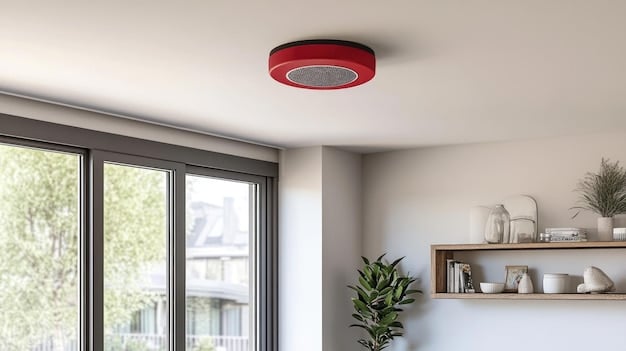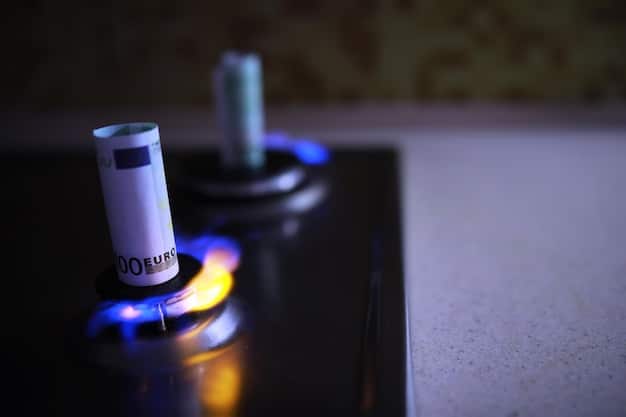Smart Home Safety: Preventing Fires and Accidents with Smart Sensors

Anúncios
Enhancing home safety through smart sensors offers a proactive approach to preventing fires and accidents, integrating advanced technology to monitor and alert homeowners to potential hazards in real-time, significantly reducing risks and providing peace of mind.
In a world increasingly driven by technology, the concept of a “smart home” has evolved beyond mere convenience to become a cornerstone of modern living. Among its many benefits, applying smart technology to home security stands out, especially when it comes to averting unforeseen disasters. Smart Home Safety: Preventing Fires and Accidents with Smart Sensors isn’t just a trend; it’s a vital step towards securing our living spaces. This article delves into how smart sensors can be leveraged to create a safer environment, protecting both property and lives from common household risks.
The Evolution of Home Safety: From Traditional Alarms to Smart Sensors
The evolution of home safety systems has drastically transformed over the decades. Once limited to simple audible alarms, these systems now integrate sophisticated technologies, offering comprehensive protection. The shift from traditional alarms to smart sensors marks a significant leap forward, providing not just alerts, but intelligent monitoring and preventative measures. This transition reflects a broader trend of leveraging connectivity and data for enhanced security. Traditional smoke detectors, for instance, rely solely on detecting smoke and sounding a local alarm. While effective, their limitations become apparent in larger homes or when occupants are away. They often lack the ability to communicate with other devices or notify external parties.
Smart smoke detectors, on the other hand, transcend these limitations. They can differentiate between smoke and steam, reducing false positives, and connect to a home’s Wi-Fi network to send alerts directly to your smartphone. This allows for immediate action, whether you’re at home or miles away. Furthermore, many smart smoke detectors integrate with other smart home devices, such as smart lights that can illuminate escape routes or smart thermostats that can shut off HVAC systems to prevent the spread of smoke. The integration of sensors capable of detecting various hazards, not just smoke, has paved the way for a more holistic approach to home safety. This includes sensors for carbon monoxide, water leaks, and even glass breakage, each playing a crucial role in a layered defense system.
Beyond Basic Detection: Advanced Smart Sensor Capabilities
Modern smart sensors offer a range of advanced capabilities that go far beyond simple detection. These capabilities leverage machine learning, artificial intelligence, and network connectivity to provide more accurate, timely, and actionable insights. For instance, some smart sensors can learn the typical patterns of a household, such as cooking times or water usage, and detect anomalies that might indicate a problem. This proactive monitoring helps identify potential issues before they escalate into major incidents.
One notable advancement is the ability of smart sensors to communicate with each other. This interconnectivity allows for a coordinated response to emergencies. If a smart smoke detector detects a fire, it can trigger smart lights to flash, unlock smart doors for easier escape, and send emergency alerts to pre-selected contacts.
* **Environmental Monitoring:** Beyond fire and CO, smart sensors can monitor indoor air quality, humidity levels, and temperature extremes, identifying conditions that could lead to health issues or structural damage.
* **Preventative Alerts:** Some sensors can issue warnings about potential problems, such as a furnace anomaly detected before a carbon monoxide leak or unusual water pressure drops that might indicate a leak in its early stages.
* **Remote Access and Control:** The ability to check sensor status, receive alerts, and even control certain aspects of your home’s safety systems from anywhere via a smartphone app provides unparalleled peace of mind.
* **Integration with Emergency Services:** Future advancements aim to seamlessly integrate smart home safety systems with local emergency services, potentially allowing for faster response times in critical situations.
The journey from a standalone alarm to a fully integrated ecosystem of smart sensors highlights a significant paradigm shift in how we approach home safety. This evolution emphasizes prevention, real-time monitoring, and intelligent response, ultimately creating a more secure and responsive living environment for everyone. Understanding these advancements is the first step towards embracing a truly smart and safe home.
Key Smart Sensors for Fire Prevention and Early Detection
When it comes to protecting your home from fires, smart sensors offer a range of solutions that go well beyond traditional smoke alarms. These devices are designed to detect various indicators of a fire, providing early warnings that can make a critical difference in preventing widespread damage or injury. The primary goal is to identify a potential fire as early as possible, allowing occupants maximum time to evacuate and emergency services to respond. Traditional fire safety protocols often relied on passive measures, but smart technology introduces an active and responsive layer of defense. This proactive approach significantly enhances the chances of mitigating severe consequences.
Smart Smoke Detectors: The First Line of Defense
Smart smoke detectors are arguably the most crucial component in a smart fire prevention system. Unlike their conventional counterparts, smart detectors offer enhanced capabilities like distinguishing between different types of smoke (e.g., from cooking versus a true fire) to reduce false alarms. They can also send instant notifications to your smartphone, regardless of your location, ensuring you’re always aware of potential dangers. Many models integrate with other smart devices, enabling functions such as turning on lights during an alarm to aid evacuation or shutting down HVAC systems to limit smoke circulation. Some even include built-in carbon monoxide detection, offering dual protection. The ability to receive remote alerts means you can quickly check on your home or alert neighbors and emergency services, potentially saving valuable time.
* **Dual-Sensor Technology:** Many smart smoke detectors use both photoelectric and ionization sensors, allowing them to detect a wider range of fire types (slow smoldering fires vs. fast-flaming fires).
* **Interconnectivity:** When one smart smoke detector goes off, all interconnected detectors in the home can sound the alarm simultaneously, ensuring everyone is alerted.
* **Battery Life Monitoring:** Smart detectors often provide notifications when their battery is low, eliminating the sudden, annoying chirps of traditional alarms and ensuring continuous protection.
* **Voice Alerts:** Some models can issue voice alerts that pinpoint the location and nature of the hazard, such as “Smoke detected in the living room.”
Smart Carbon Monoxide (CO) Detectors: The Silent Killer
Carbon monoxide is a colorless, odorless gas that can be deadly, making smart CO detectors an indispensable part of home safety. Sources of CO include furnaces, water heaters, and gas ranges, especially if not properly maintained. Smart CO detectors function similarly to smart smoke detectors by providing real-time alerts to your smartphone when dangerous levels of CO are detected. This immediate notification is vital, as occupants may not realize they are being exposed until it’s too late. Integration with other smart home systems can even trigger a smart fan to ventilate the area or a smart thermostat to shut down the heating system if a leak is detected.
The importance of CO detectors cannot be overstated due to the insidious nature of the gas. Symptoms of CO poisoning often mimic the flu, leading to delayed recognition. Smart detectors offer a critical layer of protection by sending alerts directly to your mobile device, allowing immediate action even when you’re not home to hear an audible alarm. This remote monitoring capability is especially beneficial for protecting pets left alone or elderly family members who might have difficulty reacting quickly.
Smart Heat Detectors: For Areas Where Smoke Alarms Aren’t Ideal
While smoke detectors are essential, they aren’t always suitable for every area of a home, especially places where smoke or steam is often present, like kitchens, garages, or laundry rooms. In these environments, smart heat detectors are a more appropriate choice. These sensors are designed to trigger an alarm when the ambient temperature rises rapidly or exceeds a preset threshold, indicating a potential fire. They are less prone to false alarms caused by cooking fumes or vehicle exhaust, making them ideal for these high-risk areas.
Smart heat detectors can provide valuable early warning in places where fast-flaming fires might occur due to flammable materials. Their integration into a broader smart home safety system ensures that, even if smoke isn’t immediately present, an escalating temperature will trigger an alert and initiate a coordinated response across other smart devices. This layered approach ensures that different types of fire hazards are addressed with the most suitable detection technology, creating a comprehensive and robust safety net for your entire home.
Preventing Water Damage: The Role of Smart Leak and Flood Sensors
Water damage is one of the most common and costly homeowner insurance claims, often leading to significant structural repairs, mold growth, and loss of personal belongings. Traditional methods of detecting leaks, such as visually inspecting pipes or waiting for a visible puddle, are often reactive and occur after significant damage has already begun. This is where smart home safety: preventing fires and accidents with smart sensors truly shines, offering proactive solutions to detect water leaks and floods early, minimizing potential devastation. Smart leak and flood sensors are designed to provide immediate alerts the moment contact with water is made, allowing homeowners to take swift action and prevent extensive damage.
Placement and Functionality of Smart Water Sensors
The effectiveness of smart water sensors largely depends on their strategic placement and rapid communication. These compact devices are typically placed in areas most prone to leaks, such as under sinks, near water heaters, washing machines, dishwashers, and in basements or crawl spaces. Some models are designed to detect even a few drops of water, while others can monitor larger areas for accumulating water. Upon contact with water, the sensor immediately sends an alert to your smartphone via Wi-Fi or a smart home hub. This instant notification allows you to investigate and address the leak before it becomes a major issue. Some advanced systems can even trigger automatic water shut-off valves, completely stopping the flow of water to prevent further damage, even if you’re not at home.
* **Early Detection:** The primary benefit is detecting small leaks before they turn into large-scale problems, saving homeowners thousands in repair costs.
* **Preventing Mold Growth:** By addressing leaks quickly, smart sensors help prevent the growth of mold and mildew, which can cause significant health issues and further property damage.
* **Reduced Insurance Claims:** Proactive leak detection can lead to fewer and less severe insurance claims, potentially impacting future premium costs.
* **Peace of Mind:** Knowing that your home is constantly monitored for leaks, especially when you are away on vacation, offers significant peace of mind.
Beyond Leaks: Detecting Plumbing Issues and Humidity
Smart water sensors are evolving beyond simple leak detection to monitor broader plumbing health. Some advanced sensors can track water flow patterns, pressure changes, and even humidity levels, providing insights into potential plumbing issues before they manifest as visible leaks. For example, a sudden drop in water pressure or an unusually high water usage pattern might indicate a continuous leak somewhere in the system. These sensors can learn your household’s typical water consumption habits and flag anomalies, prompting you to investigate. This proactive monitoring helps identify hidden leaks within walls or floors that might otherwise go unnoticed for extended periods, leading to substantial damage.
Furthermore, some smart sensors integrate humidity monitoring, which is crucial in preventing condensation and moisture buildup that can lead to mold and structural decay. By maintaining optimal humidity levels, homeowners can safeguard their property against long-term moisture-related damage. This holistic approach to water management underscores the evolving capabilities of smart home technology in protecting your investment and ensuring a healthy living environment. The immediate alert system, combined with preventative monitoring, makes smart leak and flood sensors an indispensable component of a comprehensive smart home safety strategy, significantly enhancing a home’s resilience against water-related accidents.

Integrating Smart Sensors for Comprehensive Home Safety
Achieving a truly comprehensive home safety system involves more than just having individual smart sensors; it requires seamless integration and communication among all devices. This unified approach ensures that different types of sensors work in concert, providing a holistic and layered defense against various hazards. The goal is to create an interconnected ecosystem where the detection of one threat can trigger a coordinated response across multiple devices, enhancing both awareness and protective measures. This goes beyond simple automation, pushing towards intelligent and responsive safety protocols that actively mitigate risks.
The Power of a Centralized Smart Home Hub
At the core of an integrated smart home safety system lies the smart home hub. This device acts as the central brain, facilitating communication between all connected sensors and smart devices, regardless of their manufacturer or communication protocol (e.g., Wi-Fi, Zigbee, Z-Wave). A centralized hub ensures that alerts from a smart smoke detector can instantly trigger actions from other devices, such as unlocking smart doors, turning on smart lights, or even activating a smart thermostat to modify HVAC behavior. Without a hub, individual sensors might function as standalone alerts, but they lose the ability to create complex, coordinated safety routines.
* **Unified Control:** Manage all your smart safety devices from a single app or interface.
* **Automated Routines:** Create custom safety routines, like “Away Mode,” which arms all sensors, locks doors, and adjusts lighting.
* **Enhanced Connectivity:** Bridges diverse devices that use different wireless protocols, ensuring compatibility and expanded functionality.
* **Remote Monitoring:** Access real-time status updates and alerts from all connected sensors, no matter where you are.
The hub also plays a critical role in data aggregation, analyzing patterns from various sensors to provide more intelligent insights and proactive alerts. For example, it might notice a pattern of high humidity combined with unusual water-flow readings and alert you to a potential developing leak before any visible signs appear.
Creating Automated Safety Routines and Scenarios
One of the most powerful features of an integrated smart home safety system is the ability to create automated safety routines and scenarios. These routines allow homeowners to define how their smart devices should react in specific situations, significantly enhancing response times and mitigating risks. For instance, a “Fire Safety” routine could be programmed to activate when a smart smoke detector alarm is triggered. This routine might automatically:
* **Unlock Smart Locks:** Ensuring quick egress for occupants and easy access for emergency services.
* **Turn on All Smart Lights:** Illuminating escape routes and making the home more navigable in smoky conditions.
* **Shut Down HVAC Systems:** Preventing the circulation of smoke and fire throughout the home.
* **Send Emergency Notifications:** Alerting family members, neighbors, or even pre-programmed emergency contacts with the details of the alarm and location.
Another scenario could be “Water Leak Response.” If a smart leak sensor detects water, the system could automatically shut off the main water valve (if equipped with a smart water shut-off device) and send an immediate alert. These automated responses reduce the time between detection and action, which is crucial in preventing extensive damage. The customization possibilities are vast, allowing homeowners to tailor their safety protocols to match their specific needs and concerns. The integration capabilities transform a collection of individual sensors into a cohesive, intelligent safety network, providing unparalleled protection against a wide range of home hazards.
Smart Doorbells and Cameras: Enhancing Perimeter Security and Accident Prevention
While the focus on smart home safety often gravitates towards internal hazards like fires and leaks, external threats and accidents close to the home’s perimeter are equally important. Smart doorbells and security cameras have emerged as crucial components in creating a holistic safety net, extending protection beyond the interior of the home. These devices offer both preventative measures and post-incident analysis capabilities, empowering homeowners with greater control and awareness of their property’s surroundings. They bridge the gap between internal detection and external vigilance, creating a truly comprehensive security posture.
Monitoring Entrances and Deterring Intruders
Smart doorbells and security cameras provide continuous monitoring of entry points, serving as a powerful deterrent against intruders and enabling real-time awareness of who is approaching your home. Smart doorbells, equipped with high-definition cameras, motion sensors, and two-way audio, allow you to see and speak to visitors from anywhere using your smartphone. If motion is detected, you receive an immediate notification, often accompanied by a live video feed. This capability is invaluable not only for identifying potential threats but also for verifying legitimate visitors, Package deliveries, or even keeping an eye on children playing outside.
* **Real-time Alerts:** Instant notifications for motion detection or doorbell presses, allowing for immediate response.
* **Two-Way Communication:** Speak to visitors or potential intruders even when you’re not home, creating the impression that someone is present.
* **Recorded Footage:** All events are typically recorded and stored in the cloud, providing valuable evidence in case of an incident.
* **Night Vision:** Ensures clear visibility even in low-light conditions, maintaining security around the clock.
Security cameras, strategically placed around the perimeter of your home, offer a broader view, covering driveways, backyards, and other vulnerable areas. Many smart cameras feature advanced analytics, such as person detection or facial recognition, reducing false alarms from pets or passing vehicles. Their ability to integrate with other smart home devices means they can trigger floodlights or activate recordings when certain events occur, further enhancing their protective capabilities.
Preventing Outdoor Accidents and Monitoring Activity
Beyond security, smart doorbells and cameras play a significant role in preventing outdoor accidents and monitoring activity around the home. For families with children or elderly residents, these devices offer an extra layer of supervision. For example, a camera pointed at a pool area can alert parents if a child approaches too close or if an unattended pet falls into the water. Similarly, cameras monitoring stairs or uneven pathways can identify potential hazards or capture footage if someone slips, providing insights into accident causes. They can also keep an eye on pets and ensure they stay within designated safe zones.
For homeowners with property that includes gardens, sheds, or detached garages, cameras can monitor activity and deter theft or vandalism. The ability to monitor these areas remotely provides peace of mind, especially when away from home. Furthermore, in the event of an outdoor accident, recorded footage can be invaluable for understanding what happened, assisting with insurance claims, or providing information to emergency services. By combining the proactive deterrence of motion-activated alerts with the observational power of continuous recording, smart doorbells and cameras significantly bolster the overall safety and security of your property, enhancing the protective umbrella of your smart home system.
The Role of Smart Lighting and Appliance Monitoring in Accident Prevention
Smart lighting and appliance monitoring might not immediately come to mind when discussions turn to home safety, but their roles in preventing accidents are surprisingly significant. These technologies contribute to a safer living environment by minimizing common household risks, from falls to electrical hazards. By integrating these systems into a broader smart home safety: preventing fires and accidents with smart sensors framework, homeowners can create a more responsive and protective ecosystem that goes beyond traditional safety measures. This proactive approach leveraging everyday technologies subtly but effectively reduces daily hazards.
Smart Lighting: Illuminating Pathways and Deterring Intruders
Smart lighting systems do more than just change colors or dim on command; they are powerful tools for accident prevention. Automated lighting can ensure that common pathways, staircases, and outdoor areas are always well-lit when someone is present, significantly reducing the risk of trips and falls, especially for children or the elderly. Motion-activated smart lights can illuminate a path as you enter a room or approach your front door, eliminating the need to fumble for light switches in the dark. This is particularly useful in entryways, bathrooms, and kitchens where visibility is crucial.
Beyond preventing falls, smart lighting also acts as a deterrent against potential intruders. Lights can be programmed to turn on and off randomly when you’re away, mimicking occupancy and making your home appear lived-in. If a security sensor (like a smart doorbell or camera) detects unusual activity, smart lights can instantly flash or turn on to full brightness, startling intruders and alerting neighbors or passersby. This integration enhances the overall security posture of your home without requiring active management on your part.
* **Automated Illumination:** Lights turn on automatically when motion is detected, preventing fumbling in the dark.
* **Timed Schedules:** Program lights to turn on/off at specific times to simulate occupancy and deter crime.
* **Emergency Response:** Integrate with smoke/CO alarms to fully illuminate escape routes during an emergency.
* **Remote Control:** Turn lights on or off from anywhere, ensuring you never return to a dark house or leave lights on accidentally.
Smart Appliance Monitoring: Preventing Electrical and Fire Hazards
Many household accidents, including fires, originate from appliances. Overheating, faulty wiring, or forgotten appliances can pose serious risks. Smart plugs and appliance monitoring systems offer a layer of protection by allowing you to control and monitor the power consumption of your devices remotely. These smart plugs can be used with “dumb” appliances, effectively converting them into smart devices. If you are rushing out of the house and forget to turn off a curling iron or a coffee maker, you can simply switch it off from your smartphone, eliminating potential fire hazards.
Furthermore, smart appliance monitoring can track energy usage patterns, alerting you to unusual spikes that might indicate an electrical fault or an appliance drawing too much power, which could lead to overheating or potential fires. Some systems can even detect if an appliance has been left on for an unusual duration. By providing real-time data and remote control over your appliances, these smart solutions empower homeowners to proactively manage electrical risks and prevent accidents that could escalate into serious threats. The combination of smart lighting for visibility and deterrence, coupled with intelligent appliance monitoring for preventing electrical-related perils, forms a robust part of a comprehensive safety strategy, enhancing overall living security.
Installation, Maintenance, and Best Practices for Smart Sensors
Maximizing the effectiveness of your smart home safety system lies not just in selecting the right sensors, but also in their correct installation, regular maintenance, and adherence to best practices. A poorly installed or neglected sensor can be as ineffective as having no sensor at all, compromising the very safety it’s meant to provide. This section outlines crucial steps and considerations for ensuring your smart sensors are always ready to protect your home. Implementing these guidelines is crucial for ensuring the long-term reliability and performance of your smart home safety: preventing fires and accidents with smart sensors system.
Strategic Sensor Placement and Professional Installation
The placement of smart sensors is critical for their optimal performance. For smoke and CO detectors, the general rule of thumb is to install them on every level of your home, including the basement, outside sleeping areas, and inside each bedroom. Avoid placing them in kitchens or bathrooms where steam or cooking fumes could trigger false alarms, opting instead for smart heat detectors in these areas. Water leak sensors should be positioned in low-lying areas prone to leaks, such as under sinks, near water heaters, washing machines, and in basements. Security cameras and doorbells require strategic placement to cover entry points and vulnerable areas without blind spots.
While many smart sensors are designed for DIY installation, professional installation can offer several advantages, especially for complex systems. Professionals ensure that all sensors are correctly connected to your smart home hub, calibrated accurately, and placed in optimal locations for maximum coverage and reliability. They can also help with integrating disparate systems and troubleshooting connectivity issues, ensuring a seamless and reliable setup. Proper placement and installation lay the groundwork for a truly effective safety system.
* **Adherence to Standards:** Ensure placement meets local building codes and safety regulations.
* **Optimal Coverage:** Professional assessment identifies blind spots and ensures comprehensive sensor placement.
* **System Integration:** Expertise in connecting all devices to the central hub for seamless communication.
* **Troubleshooting:** Assistance with initial setup and resolving any immediate technical issues.
Regular Maintenance and Battery Management
Like any safety device, smart sensors require regular maintenance to remain effective. This includes routine checks, cleaning, and timely battery replacements. While smart sensors often notify you when batteries are low, it’s a good practice to test them monthly and replace batteries annually, or as recommended by the manufacturer. Dust and debris can accumulate on sensors, particularly smoke and CO detectors, impairing their ability to detect hazards. Gently vacuuming or wiping them clean periodically can prevent this.
It’s also important to periodically test the functionality of your sensors. For smoke and CO detectors, use the test button as per manufacturer instructions. For leak sensors, you might simulate a small leak to ensure they send alerts. Regularly checking your smart home app to ensure all devices are online and communicating properly can also catch issues before they become critical. Neglecting maintenance can lead to sensor malfunctions, rendering your safety system ineffective during a real emergency.
Firmware Updates and Network Security
Smart sensors, like other connected devices, rely on firmware and software to function. Manufacturers regularly release updates to improve performance, add new features, and address security vulnerabilities. Ensuring your sensors receive these updates is crucial for their long-term reliability and safety. Often, these updates are managed through your smart home app or hub. Keeping your smart home network secure is equally vital. Use strong, unique passwords for your Wi-Fi network and smart home accounts, and enable two-factor authentication where available. Regularly review the devices connected to your network and ensure your router’s firmware is also up to date. A secure network prevents unauthorized access and ensures the integrity of your safety system, protecting against potential tampering or data breaches. By following these installation, maintenance, and security best practices, you can ensure your smart home safety system provides continuous, reliable protection for years to come.
Future Trends in Smart Home Safety Technology
The landscape of smart home safety: preventing fires and accidents with smart sensors is constantly evolving, driven by advancements in artificial intelligence, machine learning, and connectivity. As technology becomes more sophisticated and integrated into our daily lives, so too do the capabilities of smart safety systems. Looking ahead, we can anticipate a future where homes are not just reactive to hazards but are proactively intelligent, predicting and preventing emergencies with unprecedented precision. This continued evolution promises more intuitive, reliable, and comprehensive protection for homeowners.
AI and Machine Learning for Predictive Safety
One of the most exciting future trends is the deeper integration of artificial intelligence (AI) and machine learning (ML) into smart safety sensors. Currently, many sensors are reactive, alerting you once a hazard is detected. However, with AI and ML, sensors will gain the ability to learn from environmental data, identify patterns, and predict potential hazards before they fully develop. For instance, an AI-powered system might analyze subtle changes in air quality, temperature fluctuations, and utility usage patterns over time to predict the likelihood of an appliance malfunction or an impending fire. This shift from reactive to predictive safety would offer an invaluable head start in preventing disasters.
* **Early Anomaly Detection:** Systems could identify minute deviations from normal operation in appliances or utilities, signaling potential failures.
* **Contextual Awareness:** AI might understand specific household routines (e.g., cooking habits) to reduce false alarms while remaining highly sensitive to actual threats.
* **Predictive Maintenance:** Sensors could alert homeowners to potential equipment failures or maintenance needs before they cause an accident.
* **Personalized Safety Profiles:** AI could learn individual habits and preferences to tailor alerts and responses, making safety systems more intuitive and less intrusive.
Imagine a smart home system that warns you about an aging water heater component that’s likely to burst in the coming weeks, or an electrical anomaly that suggests a potential short circuit ready to ignite. This predictive capability moves beyond simple detection to proactive prevention, potentially saving lives and mitigating extensive property damage.
Enhanced Integration with Emergency Services and Autonomous Response
Another significant trend is the seamless integration of smart home safety systems with local emergency services. While some systems currently allow for alerts to be sent to
emergency contacts, future developments aim for direct and autonomous communication with fire departments, police, or medical services. In the event of a significant fire or CO leak, the smart home system could automatically transmit critical data – such as the type of emergency, its precise location within the home, and possibly even environmental readings – directly to first responders. This advanced data transfer would enable faster, more informed responses, crucial during time-sensitive emergencies.
Furthermore, autonomous response capabilities within the home are likely to expand. Beyond basic actions like shutting off water valves, future smart homes might employ small robotic units or advanced ventilation systems that can take immediate preliminary actions to contain a situation before human intervention arrives. For example, a system could autonomously activate a localized fire suppression spray in a contained space while simultaneously alerting emergency services. This level of automation, combined with real-time data sharing with first responders, represents a revolutionary leap in home safety, transforming how we protect our homes and families from unforeseen accidents and disasters. The continued evolution of smart home safety: preventing fires and accidents with smart sensors promises a future where our homes are not just residences, but intelligent guardians proactively ensuring our well-being.
Challenges and Considerations for Smart Home Safety Adoption
While the benefits of smart home safety systems are undeniable, their widespread adoption and effective implementation come with a unique set of challenges and considerations. Addressing these concerns is crucial for ensuring that these innovative technologies live up to their promise of enhanced protection. From initial setup hurdles to long-term reliability and privacy issues, homeowners must navigate various factors to fully embrace the advantages of smart home safety: preventing fires and accidents with smart sensors. Understanding these challenges is the first step towards overcoming them and building a truly secure smart home.
Connectivity and Power Reliability
Smart sensors rely heavily on stable internet connectivity and consistent power to function optimally. A home with unreliable Wi-Fi or frequent power outages can significantly compromise the effectiveness of these systems. If a sensor loses connection to the smart home hub or the internet, it might fail to send critical alerts, leaving your home vulnerable. This is particularly problematic during emergencies, when a robust connection is most needed. While many devices come with battery backups, these are generally designed for short-term outages, not prolonged disruptions.
Ensuring a strong and consistent Wi-Fi signal throughout your entire home is crucial, especially in areas where sensors are installed. This might require Wi-Fi extenders or a mesh network system. Additionally, homeowners should consider backup power solutions like uninterruptible power supplies (UPS) for their smart home hub and critical network equipment to maintain functionality during power cuts. Addressing these foundational infrastructure requirements is paramount for the dependable operation of any smart safety system. Without robust connectivity, even the most advanced sensors can fall short of their protective duties.
* **Internet Stability:** A reliable internet service provider (ISP) and robust home network are essential for continuous monitoring and alerts.
* **Wi-Fi Coverage:** Ensure strong Wi-Fi signals reach all sensor locations, using extenders or mesh networks if necessary.
* **Power Backup:** Consider UPS or smart home hubs with internal battery backup for critical components during power outages.
* **Offline Functionality:** Check if sensors offer local alarms or basic functionality even when internet connectivity is lost.
Data Privacy and Security Concerns
As smart home devices collect and transmit data, concerns about data privacy and cybersecurity naturally arise. Smart sensors often gather sensitive information about your home’s environment, occupancy patterns, and even video footage. This data could potentially be vulnerable to breaches if not properly secured. Homeowners must be vigilant about the security practices of the smart device manufacturers they choose, ensuring that data is encrypted, stored securely, and not shared without explicit consent.
It’s also crucial to protect your smart home network from unauthorized access. This involves using strong, unique passwords for all devices and accounts, enabling two-factor authentication whenever possible, and regularly updating device firmware to patch security vulnerabilities. Public Wi-Fi networks should be avoided when managing smart home settings, and a separate guest network can be used for visitors to prevent them from accessing your main smart home devices. Addressing these security considerations helps safeguard your personal data and prevents malicious actors from potentially compromising your home’s safety systems.
Cost and Compatibility
The initial investment in a comprehensive smart home safety system can be a significant consideration for many homeowners. While individual sensors may be affordable, building a complete ecosystem with multiple devices, a central hub, and professional monitoring services can add up. It’s important to budget accordingly and prioritize the most critical safety needs first, gradually expanding the system as funds allow.
Compatibility between devices from different manufacturers is another common challenge. Not all smart sensors and hubs speak the same language (e.g., Zigbee, Z-Wave, Wi-Fi, Bluetooth), leading to potential integration issues. Homeowners should research compatibility thoroughly before making purchases or choose a single ecosystem for simpler integration. Opting for devices that support open standards or platforms with broad compatibility can alleviate future headaches. While the cost of smart home safety might seem high, the potential savings from preventing a fire or flood, not to mention the peace of mind, often far outweigh the initial investment. Addressing these challenges transparently helps homeowners make informed decisions and build a robust, secure, and compatible smart home safety system.
| Key Point | Brief Description |
|---|---|
| 🚨 Fire & CO Detection | Smart sensors provide real-time alerts for smoke and carbon monoxide, notifying owners remotely. |
| 💧 Water Leak Prevention | Detects leaks early to prevent catastrophic water damage and mold growth. |
| 🏠 Perimeter Security | Smart doorbells and cameras monitor entrances and deter intruders, enhancing overall home security. |
| 🔌 Appliance Safety | Smart plugs and monitoring prevent electrical hazards and potential fires from appliances. |

Frequently Asked Questions About Smart Home Safety Sensors
Smart home safety sensors offer significant advantages over traditional alarms, primarily through remote notifications, integration with other smart devices, and often more precise detection capabilities. Unlike traditional alarms that only sound locally, smart sensors send alerts directly to your smartphone, allowing for immediate action even when you’re away from home. They can also connect to central hubs, enabling automated responses like unlocking doors or shutting off utilities during an emergency.
While smart home sensors are primarily known for detection and alerting, they also play a crucial role in prevention. Early detection of issues like small leaks or unusual temperature rises can prevent them from escalating into major accidents or fires. Moreover, integration with smart home systems allows for automated responses, such as shutting off water valves or turning off appliances, which actively prevents further damage or risks, transforming detection into active prevention.
The reliability of smart safety sensors during internet outages varies by device. Many smart sensors are designed to continue functioning as local alarms even without an internet connection, providing audible or visual alerts within the home. However, remote notifications to your smartphone or integrated actions with other cloud-connected devices will typically cease. Some advanced systems or hubs have cellular backup, allowing critical alerts to be sent over a cellular network during internet outages, maintaining a degree of remote functionality.
Regular maintenance is crucial for smart home safety sensors. It’s recommended to test smoke and CO detectors monthly using their test buttons and to clean them periodically to remove dust. Batteries should typically be replaced annually, even if the device indicates they are still good, or as recommended by the manufacturer. The sensors themselves often have a lifespan of 7-10 years, similar to traditional alarms, after which they should be replaced to ensure continued accuracy and reliability.
Absolutely. Many smart home safety systems, especially those from established security companies, offer professional monitoring services. This means that when a smart sensor detects an issue like smoke, carbon monoxide, or a water leak, the alert is sent not only to your smartphone but also to a central monitoring station. Trained professionals at the station can then verify the alarm and dispatch emergency services if necessary, providing an additional layer of security and peace of mind, particularly when you are away or unable to respond immediately.
Conclusion
Embracing smart home safety: preventing fires and accidents with smart sensors represents a significant leap forward in protecting our homes and loved ones. These intelligent systems offer a proactive, interconnected, and responsive approach to domestic hazards, moving beyond traditional reactive alarms. From early fire and carbon monoxide detection to preventing water damage and enhancing perimeter security, smart sensors provide a comprehensive safety net that continuously monitors and alerts homeowners to potential issues. While challenges such as connectivity, data privacy, and initial costs exist, the evolving capabilities of AI and seamless integration with emergency services promise an even safer and more intuitive future. Investing in smart home safety is not merely about adopting new technology; it’s about securing peace of mind and creating a resilient living environment where safety is intelligently managed.





